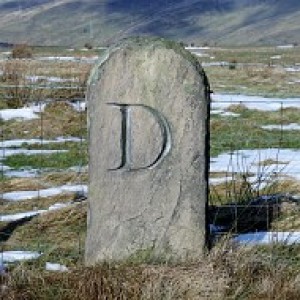Affetside Cross And A P30 Nearby On The Green, P86
Affetside is derived from the Old English ofer meaning border or boundary and side or site, meaning hillside meaning the boundary on the hill, which is appropriate as its highest point is 900 ft (277 m) above sea level. The boundary follows the route of the Roman road known as Watling Street that ran from Manchester (Mamucium) and Ribchester (Bremetennacum) built in about 72AD.
The cross is a listed grade II structure. Its shaft is made from a single piece of gritstone on a plinth consisting of two stone steps, one circular, 2.28 m (7.5 ft) in diameter, and 0.1 m (4 inches) high and a smaller one 1.6 m (5 ft 3 inches) in diameter, and 0.25 m (10 inches) high. The shaft is a pillar with a square base 0.34 m (1 ft) wide tapering to a column 1.43 m (4 ft 8 inches) high. At 1.34m (4 ft 4 inches) there is a collar with a bun shaped capital. On its top is a socket that may have held the cross head or stone ball.
ffetside Cross was damaged in the 1890s by persons mistakenly believing it concealed hidden treasure and was repaired by the Lord of the Manor. It marks the supposed half way point between London and Edinburghsand its origin remains a mystery though it is thought to date from medieval times or earlier. Its proximity to the Roman road has caused many to speculate it to be Roman but others consider it a medieval route marker for pilgrims en route to Whalley Abbey. There is an other such cross at Holcombe Moor to the east and one at Bradshaw which has been removed. The theory is plausible as the old east-west packhorse trail was a major route for the passage of goods and people. Another explanation is it is a market cross from Jacobean or Georgian times but Affetside had no market charter though markets did exist without one. It may mark the sitr of an earlier beacon due to its dominant position. The loss of the cross head is undated and there is no proof had one.

Comments
Sign in or get an account to comment.


